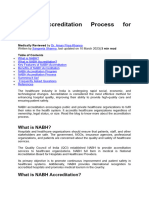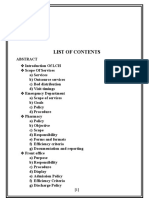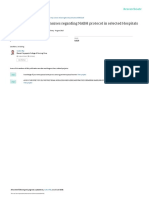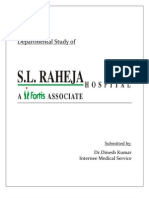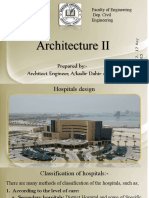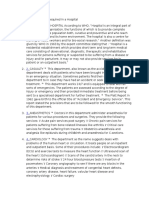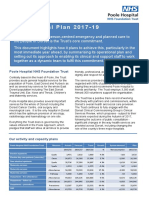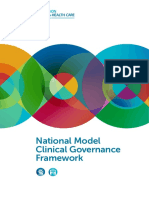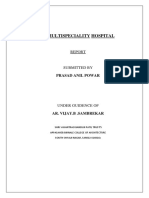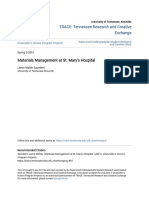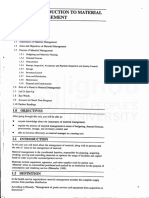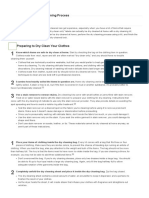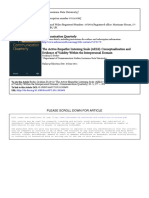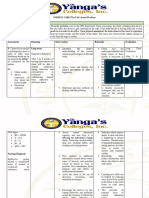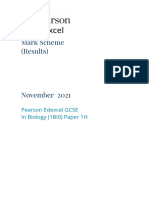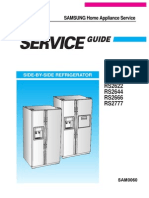Project Report
Project Report
Uploaded by
Keshava NagalkarCopyright:
Available Formats
Project Report
Project Report
Uploaded by
Keshava NagalkarOriginal Title
Copyright
Available Formats
Share this document
Did you find this document useful?
Is this content inappropriate?
Copyright:
Available Formats
Project Report
Project Report
Uploaded by
Keshava NagalkarCopyright:
Available Formats
BOMBAY HOSPITAL, INDORE
PROJECT REPORT
ON
1. “AN ANALYTICAL STUDY ON PATIENT REPORTED EXPERIENCE MEASURES”
&
2. “AN ANALYTICAL STUDY ON PATIENT SAFETY CULTURE IN HOSPITAL”
SUBMITTED TO
DR DILEEP SINGH CHAUHAN
DEPUTY DIRECTOR MEDICAL SERVICES
BOMBAY HOSPITAL, INDORE
SUBMITTED BY
DR KANCHAN CHOURASIA
MBA
(HOSPITAL MANAGEMENT)
BHABHA UNIVERSITY, BHOPAL (MP)
1
PROJECT COMPLETION CERTIFICATE
This is to certify that Dr Kanchan Chourasia has completed the project work on "An
analytical study on Patient Reported Experience Measures" & “An Analytical study
on Patient Safety in Hospital” under my direct supervision for the fulfilment of the
Hospital Administration course during her internship duration from 16/12/21 to
16/4/22.
It is also certified that no part of this report has been included in any other thesis for
processing any other degree by the candidate.
This is the original study of Dr Kanchan Chourasia and sources used by her have been
acknowledged in her report. The report is submitted as partial fulfilment of internship
training.
Dr Dileep Singh Chauhan
(Deputy Director Medical Services)
2
ACKNOWLEDGMENT
First of all, let me thank God almighty for unending love, care and blessing especially
during the tenure of this study.
I Would like to thank Dr Dileep Singh Chauhan, (Deputy Director Medical Services) for
giving me an opportunity to work as management trainee in Bombay Hospital &
Research centre, Indore.
The present study has been completed under the expert guidance of Mr Ravi Makhija
(Deputy manager-medical operations) and Dr Shantanu Bhargava (OSD). I express my
sincere gratitude to both of them for the valuable guidance, constant support and
encouragement given from the inception to the completion of the study.
I also express my sincere thanks to all staffs in wards for their constant support.
I also like to acknowledge the contribution of all participants who kindly agreed to take
part in the study. They generously gave their time and attention to the research. This
would have been impossible without such generosity.
3
DECLARATION
I hereby declare that the project on “An Analytical study on Patient Experience
Measures” & “An Analytical study on Patient Safety culture in Hospital” is a genuine
work done by me, under the guidance of Mr Ravi Makhija (Manager Medical
Operations) and Dr Shantanu Bhargava (OSD & NABH Coordinator) at Bombay
Hospital, Indore. It is also certified that this work has not been presented to any other
university for award of degree, diploma or other recognition.
Dr Kanchan Chourasia
BDS
MBA (Hospital Management)
Bhabha University, Bhopal
4
TABLE OF CONTENT
S.NO. PARTICULARS PAGE. NO.
1 INTRODUCTION TO BOMBAY HOSPITAL 7-8
2 SERVICES OFFERED BY BOMBAY HOSPITAL 9-11
3 OVERVIEW OF BOMBAY HOSPITAL 12-13
4 EXECUTIVE SUMMARY 14-15
PROJECT 1
PATIENT REPORTED EXPERIENCE MEASURES
S.NO. PARTICULARS PAGE NO.
PATIENT REPORTED EXPERIENCE MEASURES 16-21
1.
INTRODUCTION TO PROM 16
2.
BACKGROUND STUDY 17
3.
REVIEW OF LITERATURE 18
4.
NEED AND SIGNIFICANCE 19
5.
DEVELOPING PREM QUESTIONNAIRE 20
6.
CHARECTERSTICS OF PREM 21
7.
ABOUT PROJECT 22-23
8.
9. PREM QUESTIONNAIRE 24-25
10. DATA INTERPRETATION ON PREM 28-37
11. RESULTS,OBSERVATION,RECOMMENDATIONS 38
12 CHALLENGES FACED WHILE DOING SURVEY 39-40
5
PROJECT 2
PATIENT SAFETY CULTURE IN HOSPITAL
PARTICULARS
S.NO PAGE.NO
PATIENT SAFETY CULTURE IN HOSPITAL
1 41-81
INTRODUCTION TO PATIENT SAFETY
2 41
WHY DOES PATIENT HARM OCCUR
3 41
BURDEN OF HARM
4 42
5 BACKGROUND OF STUDY 43
6 REVIEW OF LITERATUREABOUT PATIENT SAFETY 44-45
CURRENT SITUATION OF PATIENT SAFETY
7 46-50
8 IMPORTANCE OF PATIENT SAFETY 51
WHAT CONSTITUTES PATIENT SAFETY
9 52-53
10 NATIONAL PATIENT SAFETY GOALS 54
PRINCIPLES OF PATIENT SAFETY
11 55
OBJECTIVES OF PATIENT SAFETY
12 56
PROJECT ON PATIENT SAFETY
13 57-58
PATIENT SAFETY AUDIT CHECKLIST
14 59-60
DATA INTERPRETATION ON PATIENT SAFETY AUDIT
15 61-76
CHALLENGES FACED WHILE ACHIEVING PATIENT SAFETY
16 79-80
CONCLUSION
17 81
6
INTRODUCTION
INTRODUCTION TO BOMBAY HOSPITAL
Bombay Hospital is a trust hospital in Indore, India. It was found in Mumbai in 1951 by
R.D Birla. It was founded in Indore in 2003. Bombay Hospital is a private hospital in
Mumbai, India. Bombay Hospital Indore is its branch located at Ring road Indore It has
600 beds (presently running 315 beds), 74 of which are in the critical care and recovery
area. It offers tertiary healthcare facilities; it also has 7 Operation Theatres and
offering services for all super specialties to the: -
• Neurosurgery
• Neurology
• Cardiology
• Gastroenterology
• Nephrology
• Onco-surgery
•Specialties like General Medicine, Paediatrics, General and Laparoscopic surgery,
Orthopaedics and joint replacement.
7
VISION
“To render the same level of service to the poor that the rich will get in a good
hospital.”
MISSION
“Bombay Hospital shall provide the best possible the best possible medical treatment,
delivered most efficiently, in the shortest possible time, at minimum cost, to all
sections of the society, irrespective of caste, creed or religion.”
MOTTO
A Patient is the most important person in our Hospital. He is not an interruption to our
work. He is the purpose of it. He is not an outsider in our Hospital, he is part of it. We
are not doing him a favour by serving him, he is doing us a favour by giving us an
opportunity to do so.
Bombay Hospital is one of the renowned hospital of central India. Located at Ring Road
of Indore, Bombay hospital is very much accessible to all parts of the city, state as well
as nation. The excellent service provided by Bombay Hospital has been recognized by
whole of the country.
PREFACE
Shri Rameshwardas ji Birla, in whose memory the endowment has been setup, was a
leading Industrialist and philanthropist who dedicated his life to medical, social,
cultural, educational and religious activities all over India. He was the pioneering spirit
behind the Bombay Hospital and was the founder Chairman of its Trust.
8
SERVICES OFFERED BY BOMBAY HOSPITAL
SCOPE OF SERVICES
1. Outpatient Services
2. Inpatient Services
3. Adult Intensive Care Services
4. Paediatric & Neonatal Intensive Care
5. High Dependency Care Services 6. Emergency Services
7. Operation Theatre Services.
DIAGNOSITICS
1. Blood Transfusion Service
2. Cath Lab
3. ECG, Echo/Stress & Holter
4. EEG & EMG
5. Histopathology
6. MRI & CT Scan
7. Pathology
8. Pulmonary Function Lab
9. Ultrasound
10. Urodynamic
11. X’RAY
CLINICAL SERVICES
1. Cardiology
9
2. Cardiac surgery
3. Chest Medicine
4. Critical Care Medicine
5. Dermatology
6. ENT (Otorhinolaryngology)
7. Gastroenterology including GI Endoscopy
8. General Medicine
9. General Surgery
10. Gynaecology and Obstetrics including High Risk Obstetrics Care
11. Medical Oncology & Haematology
12. Nephrology (Haemo & Peritoneal Dialysis)
13. Neurology
14. Neurosurgery
15. Ophthalmology
16. Orthopaedics
17. Joint Replacement
18. Paediatrics & Neonatology
19. Plastic Surgery
20. Psychiatry
21. Surgical Oncology
22. Urology including Renal Transplant
23. Anaesthesiology
RELATED SERVICES
1. Ambulance
2. Executive Heath Check-up
3. Housekeeping
10
4. Kitchen & Dietary Services
5. Laundry
6. Nursing
7. Physiotherapy 8. Security & Fire Safety
ROUND THE CLOCK
1. Admission
2. ECG & X-RAY
3. Path Lab
4. Pharmacy
HEATH LIBRARY
1. Heath Tips
2. Heath Education
3. Tests and Procedures
ADMINISTRATIVE SERVICES
1. Medical Administration
2. Accounts & Finance
3. Marketing
4. TPA & Health Insurance Claims
5. Biomedical Engineering
6. Engineering Services
7. Human Resource 8. IT Department
9. Material Management
10. Medical Record Department
11. Quality Assurance Cell
11
SURGICAL
1. Cardiovascular & Thoracic Surgery
2. Ear/Nose/Throat (ENT)
3. General Surgery
4. Renal Transplant
5. Neurology
6. Obstetrics & Gynaecology Surgery
7. Ophthalmology
8. Orthopaedics
9. Plastic Surgery
10. Surgical Oncology
11. Urology
12. Gastrointestinal, Laparoscopic & Hepato-Pancreatic-Biliary Surgery
12
OVERVIEW OF BOMBAY HOSPITAL
EAST WING
12TH FLOOR •DELUXE AND FIRST CLASS BEDS
11TH FLOOR • PRIVATE CORPORATE WARD
10TH FLOOR • ARTIFICIAL KIDNEY UNIT/NICU/SEMI-PRIVATE BED
9TH FLOOR • NURSE'S HOSTEL
8TH FLOOR • NURSE'S HOSTEL
7TH FLOOR • GENERAL WARD
6TH FLOOR • COLLEGE OF NURSING
5TH FLOOR • FEMALE GENERAL WARD,LABOUR ROOM
4TH FLOOR • ICU
3RD FLOOR • MESS
2ND FLOOR • RECOVERY ROOM
1ST FLOOR • ADMINISTRATION, OPD
GROUND FLOOR • OPD, CASUALTY, ADMISSION,
DISCHARGE,PHARMACY,PATHOLOGY
1ST BASEMENT • X-RAY, PHYSIOTHERAPY,BLOOD BANK
2ND BASEMENT • STORE,LAUNDRY
13
WEST WING
12TH FLOOR • DELUXE ROOM,PRIVATE ROOM
11TH FLOOR • PRIVATE WARD
10TH FLOOR • SEMIPRIVATE WARD
9TH FLOOR • NURSE'S HOSTEL
8TH FLOOR • NURSE'S HOSTEL
7TH FLOOR • SEMI-PRIVATE WARD
6TH FLOOR • NURSING COLLEGE
5TH FLOOR • MALE GENERAL WARD
4TH FLOOR • CARDIAC ICU
3RD FLOOR • MESS
2ND FLOOR • OT
1ST FLOOR • DIAGNOSTIC & CONSULTING ROOM
GROUND FLOOR • HELP DESK,TEMPLE
1ST BASEMENT • CT SCAN,MRI
2ND BASEMENT • LINEN DEPARTMENT
14
EXECUTIVE SUMMARY
Patient-reported experience measures (PREMs) can be used in healthcare for different
specific purposes, but essentially they are used to improve the quality of healthcare
services, be it at the national level, the institutional level or the individual patient level.
PREMs are meant for the measurement of outcomes for which it is likely that patients
are the best judges. They are usually applied in the context of a larger endeavour to
improve patient participation, patient-centeredness and patient empowerment,
alongside other instruments such as patient panels, qualitative interviews with
patients, patient education and patient diaries. Patients are increasingly regarded as
the primary decision maker regarding their health and an equal partner in their
healthcare choices.
PREMs are classified as functional or relational. Functional PREMs examine practical
issues, such as the facilities available. Relational PREMs identify the patients'
experience of their relationships during treatment, e.g. did they feel listened to. The
CARE measure, a relational questionnaire, is an example of a PREMs tool.
PREMs can be recorded on different areas like Doctors, Nursing staff, Dietary services,
Housekeeping, Management etc. In this report we explain what PREMs are and explore
how and why they could be relevant to patients and clinicians.
Example of PREMs Questionnaires: In this example, responses are scored on a five (5)
point scale. The options to grade the experience are, fair, good, very good, and
excellent.
How good was the practitioner at:
Making you feel at ease
Letting you tell your story
Being interested in you as a whole person
Explaining things clearly
15
Making a plan of action with you
Using relational PREM as tool for conducting the study a questionnaire was prepared
which has details about how was consultant and their behaviour with patient during
treatment. Hence, a proper preprepared PREM’s questionnaire is shared by Dr
Shantanu Bhargava sir.
Then survey is conducted on inpatients of Bombay hospital from general wards,
semiprivate wards and private wards. The questionnaire survey was taken on the day
of patient discharge date.
Similarly, Patient safety and its importance in Quality is also explained in this project
report. Let us first discuss about patient safety.
Patient safety is the reduction of unnecessary harm associated with health care to an
acceptable minimum. It is a fundamental element of health care and is intended for
freedom for a patient from unnecessary harm or potential harm associated with
provision of health care.
A few of the most common types of medical errors include: medication errors, errors
related to anaesthesia, hospital acquired infections, missed or delayed diagnosis,
avoidable delay in treatment, inadequate follow-up after treatment, inadequate
monitoring after a procedure, failure to act on test results, failure to take proper
precautions, and technical medical errors.
Managing medical errors is more complex, it has been based on the “personal
approach”, the individual involved in the care at the time of incident are held
responsible, which is referred to as blaming. Systematic improvements cannot be
made as long as we focus on blaming individuals.
16
Studying these mistakes, learning how to prevent, monitor, and respond to them is key
to changing the standards of care. By working to eliminate common medical errors,
healthcare systems and providers can protect patients, protect themselves, improve
standards of care, and lower costs.
Thus in order to reduce medical errors and improve patient safety in hospital, patient
safety audit checklist is prepared as per NABH guidelines. This pre-prepared patient
safety audit checklist was shared with me.
I conducted survey on inpatients in semiprivate wards, general wards, private wards,
all ICU’s. I selected the patients randomly. I have gone through the patient files and
interviewed the nursing staff to complete the checklist. I have also gone through the
patient medication table to look for their medicines. In this way I have collected data
from about 200 patients.
To reach conclusion and to make decision, data is analysed, and transformed into
useful information. Data analysis involved individual who understand information
management, have skill in data aggregation method, and known how to use various
statistical tools. Result of data analysis need to be reported to those individuals
responsible for the process or experience being measured and who can take action on
the result. These individual may be clinical, managerial, or a combination
Understanding statistical technique is helpful in data analysis, especially in interpreting
variation and deciding where improvement needs to occur. Run charts, control charts,
histograms, and pare to charts, are example of statistical tool useful in understanding
trends and variation in health care.
17
A quality improvement program is only as valid as the data that are collected. Reliable
measurement is thus at the core of all implements. To ensure that good, useful data
have been collected, an internal data validation process need to be in place.
This project has also tried to emphasize on when to validate the data.
• A change has been made to an existing measure, such as the data collection tool
have changed or the data abstraction process or abstractor has changed.
• The data resulting from an existing measure have changed in an unexplained way.
• The data source has changed such as when part of the patient record has been
turned into an electronic format and thus the data source in now both electronic and
paper.
The primary goal of the Bombay hospital Indore is to find the different ways of
improving quality of care provided to patients, in intend provide a benchmark data
with respect to the current system in order to assist the streamlining process.
18
PROJECT 1
PATIENT REPORTED EXPERIENCE MEASURES
INTRODUCTION
PREMs gather information on patients’ views of their experience whilst receiving care.
They are an indicator of the quality of patient care, although do not measure it
directly. PREMs are most commonly in the form of questionnaires PREMs do not look
at the outcomes of care but the impact of the process of the care on the patient’s
experience e.g. communication and timeliness of assistance.
PREMs can be classified as either relational or functional. Relational PREMs identify the
patients experience of their relationships during treatment, e.g. did they feel listened
to. Functional PREMs examine more practical issues, such as the facilities available.
Example of PREMs Questionnaires
In this example, responses are scored on a five (5) point scale. The options to grade the
experience are, fair, good, very good, and excellent.
How good was the practitioner at
Making you feel at ease
Letting you tell your story
Being interested in you as a whole person
Explaining things clearly
Making a plan of action with you
19
PREMS are a feature of Patient-centeredness (PC). PC is about treating a person
receiving healthcare with dignity and respect and involving them in all decisions about
their health. This type of care is also called ‘person-centred care’. It is an approach
linked to a person’s healthcare rights. When healthcare professionals and services give
you patient-centred care, they put you at the ‘centre’ of your healthcare, while
treating you with dignity, respect and compassion.
Patient-centred care is more than just how your healthcare professional treats you. It
is also about how healthcare services and governments create and support policies to
put healthcare users, not healthcare organisations, at the centre of care.
The information gathered from PREMs has several uses: research, quality
improvement projects, audit, and for economic evaluation. The data collected also
provides vital feedback to healthcare providers to allow comparisons in clinical care.
PREMs provide insight into the quality of care during the intervention. Patients can
distinguish between clinical effectiveness, safety and their experiences. This highlights
how significant PREMs are and their importance in helping to provide superior quality
of care.
20
BACKGROUND OF STUDY
The inclusion of patient’s experiences is a central pillar of quality in health care.
Measuring patients’ experiences is thought to provide transparency, to improve client
safety and clinical effectiveness, and can lead to more involvement in decision-making
and to more effective healthcare professional-patient relationships.
Measuring experiences can be done with Patient Reported Experience Measures
(PREMs), which are defined as “a measure of patients’ perceptions of their personal
experiences of the healthcare they have received”. The Dutch Association for People
with Disabilities promotes the use of PREMs and judged a selected number of PREMs
as suitable for the Dutch disability sector.
One of those PREMs is called “Dit vind ik ervan!” (English “How I feel about it!”), which
was especially developed for people with intellectual, developmental and acquired
disabilities. This group often faces communication vulnerabilities. Communication
vulnerable people are people experiencing difficulties with the expression of needs or
understanding information.
“Dit vind ik ervan!” is a personalized and narrative PREM, consisting of an exploratory
dialogue between the professional and the patient to discover the patient’s personal
experiences with care. The PREM includes ten topics: family, feelings, house, feeling
safe, friends and acquaintances, participating, help, choosing, doing, and body. patient
themselves decide whether and which topics they want to discuss. Patient can score
topics from bad to good and indicate whether the topic needs change.
21
Currently, “Dit vind ik ervan!” is used at over 30 disability organisations in the
Netherlands. At SGL, professionals are trained in two versions of “Dit vind ik ervan!”:
(1) “I am speaking”: suitable for clients who can verbally communicate; the dialogue is
performed with the client alone, and (2) “I see and am speaking”: suitable for clients
who need support to verbally communicate; the dialogue is performed with the
patient and the patient’s informal caregiver.
Recently, PREMs are increasingly promoted to be used as an integrated measurement
strategy. This means that PREM outcomes are used integrative at three levels: (1) at
the micro level, which is the patient-professional level, to enhance the delivery of
appropriate care and the development of individual support plans: (2) at the meso
level, which is the organisational level, to monitor quality of care and enhance team
reflection, and (3) at the macro level, to facilitate external reporting about quality of
care.
However, uncertainty and limited insights exist regarding the implementation of
PREMs in routine care for this purpose. Foster’s systematic review shows that time and
resources are required to design the PREM process in policy of the organisation (i.e.,
planning how data will be managed and used) and to prepare the organisation for the
implementation (i.e., training professionals to use the PREM). However, a deeper
understanding of practical issues surrounding implementation of PREMs to understand
these processes seems to be necessary.
22
REVIEW OF LITERATURE
Patient ratings of health care are an integral component of patient-centred care. In
essential dimensions of patient-centred care, the Institute of Medicine (now known as
the National Academy of Medicine) includes shared decision making among clinicians,
patients, and families; self-efficacy and self-management skills for patients; and the
patient’s experience of care.
Measurement of patient ratings is a complex concept that is related to perceived
needs, expectations of care, and experience of care. Clinicians recognition of patient
preferences and values can help health care professionals tailor treatments based on
informed decisions that their patients might make based on those preferences
The three major types of patient health care ratings relate to evaluations of patient
satisfaction, patient motivation and activation, and patient reports of their actual
experiences. Patient satisfaction is a multidimensional construct that includes patient
concerns about the disease and its treatment, issues of treatment affordability and
financial burden for the patient, communication with health care providers, access to
services, satisfaction with treatment explanations, and confidence in the physician.
Shikiar and Rentz proposed a three-level hierarchy of satisfaction:
(1) satisfaction with health care delivery, including issues of accessibility, clinician-
patient communication, and quality of facilities;
23
(2) satisfaction with the treatment regimen, including medication, dietary and exercise
recommendations, and similar elements of therapies; and
(3) satisfaction with the medication itself, rather than the broader treatment.
Patient satisfaction has important implications for clinical decision making and
enhancing the delivery of health care services; it is increasingly the focus of research
and evaluation of medical treatments, services, and interventions. It is an important
indicator of future adherence to treatment. Satisfaction has a long history of
measurement, and numerous instruments are available.
One potentially important predictor of health outcomes is patient activation, or the
degree to which patients are motivated and have the relevant knowledge, skills, and
confidence to make optimal health care decisions. Hibbard and colleagues developed a
13-item scale, the Patient Activation Measure (PAM), which demonstrated favourable
psychometric properties in several cross-sectional and some longitudinal studies.
Although appreciation of the benefits of activated patients is increasing,
commensurate support is lacking to help patients become more activated with respect
to their health care decision making. Although research supports the claim that
improvements in patient activation are associated with improvements in self-reported
health behaviours, additional research is necessary to better understand both these
relationships and their relevance to actual behaviour. Patient activation, as measured
by the PAM or otherwise, may be a useful moderator or mediator of PROs that will in
turn contribute to performance measurement.
THREE LEVEL HIERACHY OF SATISFACTION
24
NEED AND SIGNIFICANCE OF PREM
The information gathered from PREMs has a number of uses: research, quality
improvement projects, audit, and for economic evaluation. Data gathered helps to
improve and focus patient-centred clinical management but also provides vital
feedback to health care providers to allow comparisons in clinical care.
PREMs provide insight into the quality of care during the intervention. They are often
used to present the patients’ perceptions of both the process of their care.
Black et al. have shown there is a positive correlation between experience and
outcomes and that patients can distinguish between clinical effectiveness, safety and
their experiences. ‘Patient outcomes can increase patients experience ratings by 10%,
similarly improving patient experience ratings will cause a 3% improvement on
outcome scores’. This highlights PREMs are important in helping to provide superior
quality of care.
Patient satisfaction is an attitude. Though it does not ensure that the patient will
remain loyal to the doctor or the hospital, it is still a strong motivating factor. Patient
satisfaction is only an indirect or a proxy indicator of the quality of doctor or hospital
performance.
25
Delivery of patient-focussed care requires that we provide care in a particular way, not
just sometimes or usually, but always. It must be every patient every time.
It is an ironic fact - the better you are, the better you must become. Quality does not
stand still. It should be linear and always ascending. One should strive to provide
better care and soar above each and every patient's expectations.
“A satisfied patient is a practice builder”.
DEVELOPING PREM QUESTIONNAIRE
Choosing the right questionnaire may be hard and developing a new one even more
challenging. The systematic review by Barnett et al. found a number of questionnaires
existed to measure PREMs. Many however lacked appropriate psychometric testing
and design to be able to determine their validity as measures of patient satisfaction.
The construction of a successful tool requires a defined psychometric development
process and validation in practice. In order to produce a questionnaire for patients, it
seems sensible to involve patients in each step of the development. A recent white
paper from the American Society of Anaesthesiology (ASA) suggests the following
steps are undertaken when building a patient questionnaire (as summarized in Table)
ASA (American Staffing Association) recommendations for building a patient
questionnaire.
Steps required Method
for
building a
patient
questionnaire
26
Item Gather the opinions of patient focus groups and relevant health care
generation professionals. A literature search may be performed to help define
what is considered important Questions may be formulated and
separated into dimensions within the questionnaire. A modified
Delphi process may be used to help distil down relevant items and
place them into dimensions
Construct pilot The number of questions should be reduced to a pre-determined
questionnaire number. Questions should be amended for comprehensibility, skew
and variability
Test the pilot The pilot questionnaire is tested for its reliability, validity and ease
questionnaire of understanding. There should be a clear description of how and
when the questionnaire will be used. At this stage further questions
may be removed that prove ambiguous or unnecessary
A revised pilot The revision is then written and tested in a different group of
questionnaire patients. This may be done by face-to-face interviews, written
mail, over the telephone or electronically
Eliminate items Reliability may be measured using statistical analysis such as
that perform Cronbach’s alpha test, with an acceptable value of 0.7–0.95. Validity
poorly may be assessed utilizing multi-trait analysis and acceptability may
be gauged looking at time to complete and response rates .
Retest the final Once developed the questionnaire may be retested to determine
questionnaire that the scores continue to exhibit reliability and construct validity
It may seem simpler to utilize questionnaires that already exist and have been
validated, however, selecting questions from statistically validated surveys does not
guarantee production of a new equally valid survey. Equally there is also no guarantee
that combining surveys will yield a new validated ‘super survey’. When constructing a
new survey, utilizing questions and themes from previously validated surveys is more
likely to produce something reliable and robust.
USING PREM TOOL
A number of PREMs questionnaires have been developed; therefore, choosing the
correct tool can be difficult. The target patient group, content, reliability, and validity
27
of the questionnaire should be considered, in addition to its prior use in a similar
patient demographic. A pilot of the questionnaire prior to commencing the PREMs
data collection is vital to identify inappropriate questions for the population.
CHARECTERSTICS OF PREMs
Quality measures designed to capture performance on Patient reported experience
measures should be
Supplemental
Psychometrically sound
In addition to the usual validity and reliability criteria, the measure developer
should consider cultural and language considerations, and patients’ burden of
responding.
Person-centred—Quality measures should reflect collaboration and shared
decision-making with patients. Patients become more engaged when they can
give feedback on outcomes important to them.
Meaningful—Quality measures should capture impact on health-related quality
of life, symptom burden, experience with care, and achievement of personal
goals.
Amenable to change—Outcomes of interest must be responsive to specific
healthcare services or intervention.
Implementable—Data collection directly from patients involves challenges of
burden to patients, health literacy of patients, cultural competence of measured
28
entities, and adaptation to computer-based platforms. Evaluation should
address how to manage these challenges.
ABOUT PROJECT
Aim
To study and analyse patient experience regarding the inpatient services and
treatment and their relation with clinicians in Bombay Hospital, Indore.
Objectives of the study
The patient feedback analysis will provide decision makers with an accurate
portrayal of whether or not the patient’s needs are being efficiently addressed
by a specific program or services.
To analyse the communication and relation of consultants with their patients
The purpose of this analysis is to identify and review the literature that examines
patient complains and patient’s satisfaction in the context of clinical practices,
how patients are treated by their consultants and improvement of all support
services.
To ensure that a currently implemented program or service is effectively
meeting the need of the patient.
To analyse the patient feedback as means to enhance future program
development
Process of Description
29
In this study description, I have taken this type of analysis tool- DMAIC Method
(Define-Measure-Analysis-Improve-Control).
I will also use some statistical tool as graphs and charts.
Research Methodology
Measure What is the capability of the process
Analyse When & where do defects occur?
Improve How can process capability are the vital factors?
Control What control can be put in place to sustain in gain?
Study type: Analytical Study: Analytical Research, involves the evaluation of available
information in an attempt to explain complex phenomenon.
Population: Patients at Inpatient Department
Sample Size: 233 Patients
Setting: BOMBAY HOSPITAL, INDORE
Data Collection: The majority of PREMs questionnaires are given to patients in
preoperative clinics at the point of initial contact (on-site feedback), with the
postoperative form being posted to each individual participating in the data collection
(post-contact feedback). The data should be collected at a pre-specified time point in
relation to the event or disease being studied. The optimal timing to complete the
questionnaire will vary with each patient and procedure.
30
The target data are independent, patient perceptions of their health status and care;
therefore, questionnaires should be completed away from health care professionals,
only aided by a friend or relative if required.
PREMs can be distributed via email, telephone calls, and more recently text messages,
giving instant feedback on patient care. Online surveys and face-to-face interviews can
also be used to collect data. In this project I have followed following type:
Primary data: “By direct filling up patient reported experience measure (PREM)
from Patients”
Secondary data: “By observing the services provided to the patient”
Development of Tool: PREM form is prepare & filled up by patient or by him/her
relatives regarding with the consultants and their behaviour.
PATIENT REPORTED EXPERIENCE MEASURES
Patient Details:
Please Enter your Details:
Name of Patient………………………
IP Number………………………………
Name of Consultant………………………………………………………
Gender: Male…………...Female………………………………………
Age………………………………………………………………………
Date of Admission…………………………………………………….
Date of Discharge…………………………………………………….
Please choose the appropriate option whichever you feel is suitable for you:
1. How good was the practitioner /consultant at making you feel at ease
(introducing himself/herself, explaining his/her position, being friendly and
warm towards you, treating you with respect; not cold or abrupt)
31
a. Poor
b. Fair
c. Good
d. Very good
e. Excellent
f. Does not apply
2. How good was consultant at letting you tell a story (giving you a time to describe
your condition in your own words; not interrupting, rushing or diverting you)
a. Poor
b. Fair
c. Good
d. Very good
e. Excellent
f. Does not apply
3. How good was practitioner /consultant at really listening (paying close attention
to what you were saying; not looking at notes or computer as you were talking)
a. Poor
b. Fair
c. Good
d. Very good
e. Excellent
f. Does not apply
4. How good was the practitioner consultant at being interested in you as a whole
person (asking/knowing relevant details about your life, your situations; not
treating you as just a number)
a. Poor
b. Fair
c. Good
d. Very good
e. Excellent
f. Does not apply
5. How good was practitioner/consultant at fully understanding your concerns
(communicating that he/she had accurately understood your
concerns/anxieties; not overlooking or dismissing anything.)
a. Poor
b. Fair
c. Good
d. Very good
32
e. Excellent
f. Does not apply
6. How good was the practitioner/ consultant at showing compassion and care
(seeming genuinely concerned, connecting with you on a human level; not being
indifferent or detached)
a. Poor
b. Fair
c. Good
d. Very good
e. Excellent
f. Does not apply
7. How good was practitioner/consultant at being positive (having a positive
approach and a positive attitude; being honest but not negative about your
problems.)
a. Poor
b. Fair
c. Good
d. Very good
e. Excellent
f. Does not apply
8. How good was the practitioner /consultant at explaining things clearly ( fully
answering your questions; explaining clearly; not being vague)
a. Poor
b. Fair
c. Good
d. Very good
e. Excellent
f. Does not apply
9. How good was the practitioner /consultant at helping you take control
(exploring with you what you can do to improve your health ,yourself
encouraging rather than lecturing you.)
a. Poor
b. Fair
33
c. Good
d. Very good
e. Excellent
f. Does not apply
10.How good was practitioner /consultant at making a plan of action with you
(discussing the options, involving in decisions as much as you want to be
involved; not ignoring your views)
a. Poor
b. Fair
c. Good
d. Very good
e. Excellent
f. Does not apply
11.If you would like to add further comments on this consultation, please do add
them here.
……………………………………………………………………………………………………………………………
…………………
Sampling Technique: In the study the patient’s or by their relatives at Bombay Hospital
were selected by random sampling technique.
Data collection: The collection of data was started from January 2022 to March 2022.
Interviews: Interviews have been used to good effect to collect one-off information
from patient which is then fed into initiatives to improve quality or safety. Very in
depth interviews are sometime used as part of an experiences based-co-design
approach whereby patient asked to comment on their experience in order to shape
improvement in care. Although interview is well-known technique.
34
What needs to be measured: The concept of patient experience has many domains. A
systematic review of instruments for measuring patient experience identified 13 core
components being measured:
Patient–professional relationship – Professional care – Information and advice –
Communication skills – Trust Organizational aspects – Accessibility/availability –
Medical and technical facilities – Office characteristics – Office organization/waiting
time – Office staff Overarching assessments – Success of outcome – General
satisfaction – Willingness to recommend service
HOW TO MEASURE PREMs
According to the research evidence, the top 10 things to consider when selecting how
to measure patient experience are as follows.
1. Consider exactly how patient experience is being defined as this will impact on how
it is measured.
2. Think about why patient experience is being measured and the uses to which the
information will be put.
3. Consider whether it will be useful to combine approaches so both qualitative and
more quantitative material is collected.
4. Consider whether to ask everyone using services or only a sample to provide
feedback. The approach should be guided by what the data collection aims to achieve.
5. Think about when people may provide the most useful feedback. The best time to
collect feedback may be immediately after using services, when experiences are fresh
in people’s minds, but this does not allow time for reflection.
6. Allocate enough time at the outset to plan and test measurement methods,
particularly if these will be used for many years to monitor change over time.
35
7. Think about the way the end-result needs to be presented for various audiences as
this may shape how the information is collected. Outputs may include detailed reports,
simple indicator scorecards, in-depth quotes, statistics and averages and graphs.
8. Make sure that there is appropriate infrastructure at an organizational level to
analyze and use the information. There may be little point in measuring patient
experience if the information will not be used robustly.
9. Make sure that patients, carers, managers and health professionals are comfortable
with why feedback is being collected and how it will be used. Patients and carers are
more likely to provide useful feedback if this is encouraged by staff.
10. Patient experience is only one indicator of the quality of healthcare. It is important
that patient experience measures are seen as one component of a broader framework
of measurement and that all of the approaches work well together, without excessive
burden for either staff or patients
DATA INTERPRETATION
How good was the practitioner /consultant at making you feel at ease (introducing
himself/herself, explaining his/her position, being friendly and warm towards you,
treating you with respect; not cold or abrupt)
Performance %
Poor 0
Fair 0
Good 26
Very Good 194
Excellent 13
Grand Total 233
36
Consultant making feel at ease
13; 6% 0; 0% 0; 0%
26; 11%
194; 83%
Poor Fair Good Very Good Excellent
How good was consultant at letting you tell a story (giving you a time to describe
your condition in your own words; not interrupting, rushing or diverting you)
Performance %
Poor 0
Fair 0
Good 43
Very Good 171
Excellent 19
Grand Total 233
37
Consultant at letting you tell a story
19; 8%0; 0%
43; 19%
171; 73%
Poor Fair Good Very Good Excellent
How good was practitioner /consultant at really listening (paying close attention to
what you were saying; not looking at notes or computer as you were talking)
Performance %
Poor 0
Fair 1
Good 54
Very Good 156
Excellent 22
Grand Total 233
38
Consultant paying close attention
0; 0% 1; 0%
19; 8%
54; 24%
156; 68%
Poor Fair Good Very Good Excellent
How good was the practitioner consultant at being interested in you as a whole
person (asking/knowing relevant details about your life, your situations; not treating
you as just a number)
Performance %
Poor 0
Fair 29
Good 102
Very Good 91
Excellent 11
Grand Total 233
39
Consultant at being interested in you as whole person
0; 0%
22; 9% 29; 12%
91; 37%
102; 42%
Poor Fair Good Very Good Excellent
How good was practitioner/consultant at fully understanding your concerns
(communicating that he/she had accurately understood your concerns/anxieties; not
overlooking or dismissing anything.)
Performance %
Poor 1
Fair 10
Good 92
Very Good 116
Excellent 14
Grand Total 233
40
Consultant fully understanding your concerns
1; 1% 10; 4%
22; 9%
92; 38%
116; 48%
Poor Fair Good Very Good Excellent
How good was the practitioner/ consultant at showing compassion and care
(seeming genuinely concerned, connecting with you on a human level; not being
indifferent or detached)
Performance %
Poor 0
Fair 6
Good 89
Very Good 122
Excellent 16
Grand Total 233
41
Consultant at showing compassion and care
0; 0% 6; 3%
22; 9%
89; 37%
122; 51%
Poor Fair Good Very Good Excellent
How good was practitioner/consultant at being positive (having a positive approach
and a positive attitude; being honest but not negative about your problems.)
Performance %
Poor 0
Fair 4
Good 65
Very Good 143
Excellent 21
Grand Total 233
42
Consultant showing positive attitude
22 4
65
143
Poor Fair Good Very Good Excellent
How good was the practitioner /consultant at explaining things clearly (fully
answering your questions; explaining clearly; not being vague)
Performance %
Poor 0
Fair 3
Good 71
Very Good 133
Excellent 26
Grand Total 233
43
Consultant at explaining things clearly
3; 1%
0; 0%
22; 10%
71; 31%
133; 58%
Poor Fair Good Very Good Excellent
How good was the practitioner /consultant at helping you take control (exploring
with you what you can do to improve your health, yourself encouraging rather than
lecturing you.)
Performance %
Poor 0
Fair 11
Good 72
Very Good 127
Excellent 23
Grand Total 233
44
Consultant at helping you take a control
11; 5%
0; 0%
22; 9%
72; 31%
127; 55%
Poor Fair Good Very Good Excellent
How good was practitioner /consultant at making a plan of action with you
(discussing the options, involving in decisions as much as you want to be involved;
not ignoring your views)
Performance %
Poor 0
Fair 19
Good 87
Very Good 111
Excellent 16
Grand Total 233
45
Consultant at making a plan of action with you
0; 0%
22; 9% 19; 8%
87; 36%
111; 47%
Poor Fair Good Very Good Excellent
RESULTS
A total of 233 inpatients were surveyed in Bombay hospital Indore including all
general, semiprivate and private wards. Out of which majority of patients were in
middle aged group and 82 of them were females and 151 were males.
OBSERVATION
Performance in majority of questions of survey from inpatients was very good. 1 or 2
questions out of 10 got average response about consultants which can be discussed
with consultants in order to provide more satisfactory care to the inpatients.
RECOMMENDATIONS:
Consultants in Bombay Hospital are very high skilled and doing their job satisfactorily.
Patients surveyed did not have any complaint regarding their treatment and their
46
behaviour, but there are certain grey areas where management with consultants can
work upon to make strong bond with patients which are discussed below;
Consultants do not have much time that they can personally enquire and take
history of every patient by asking about their personal life, professional life as
there are large number of patients in OPD and IPD waiting for consultation. So
RMO’s/ DNB’s/nursing staff appointed on duty can take initial assessment of
patients while they are waiting at Patient Waiting area and the same can be
briefed to consultant once patient enters to consultant’s chamber. So consultant
can discuss on specific points with patient. This will keep patients engaged in
treatment while they are waiting and also consultant timings are saved. Also this
will create a strong bond between both of them making patients more
comfortable during their treatment.
Consultant’s medical assistants can do counselling of patients at the time of
discharge and guide them about how to maintain healthy lifestyle and where
they can make improvements to make their life better.
Patient waiting time is higher in opd particularly between 11:00 to 2:00pm.
Avoiding unnecessary waits is crucial for patients as well as Hospital. This can be
done by implementing Computerized Appointment system.
Consultants may not be able to take call from every patient but encouraging
staff members to return messages and emails in a timely manner can help make
patients feel like their health and well-being are priorities for Hospital.
Hospital can start an online patient portal which is a secure health portal in
order to communicate with their physicians and manage their health records.
The online patient portal can help patient check their test results, schedule
appointments, leave messages for your physician.
A telehealth solution like evisit can cut average hospital visit time in half. It can
also eliminate time spent travelling to hospital or sitting in the waiting room.
47
Mobile queue tools are a great way to keep wait times down and patients
happy. Applications like Qless allow your staff know if patients are running
behind. Before patients come to hospital, they can join virtual that updates staff
on patient position. Keeping in constant communication with patients gives
them greater control over their time and helps the staff to manage the patient
flow.
Discharge process is very lengthy and time consuming in hospital. One big
reason for delays is the discharge summary completion. Usually junior doctors
fill the discharge summary at the last minute, after the consultant has confirmed
patient discharge. Updating patient file on regular basis will ensure that the
complete information from the time patient is admitted is recorded. One way to
automate this step is to maintain electronic patient charts and adopt an efficient
EMR system. This will allow medical staff to update observations, medication,
treatment plans etc. directly to charts making discharge summary process much
easier.
These small changes can improve quality of care provided by consultants thereby
Bombay Hospital.
CHALLENGES WHILE DOING PREM QUESTIONNAIRE SURVEY
Analysing the complaints or compliments that patient and families submit to health
services can also be a source of feedback about patient experiences, especially when
systematic analysis approach is implemented. Instead of attempting to use such data
as the basis for initiating quality improvement measures, complaints were consigned
to a black hole where their existence was conveniently forgotten.
Potential Limitations May provide in-depth information, particularly about things that
need improvement. If using formal system, it may be more likely to elicit feedback
from people who feel confident complaining, who may also be more literate.
Can be identify things that people feel particularly passionate or concerned about,
since it relies on spontaneous reporting Biased towards the more serious (or more
positive) aspect of care rather than acknowledging a continuum May not have large
48
number of complaints or compliments to work from May be in danger of focusing
upon individual issues rather than broader pathway of care or service redesign.
The limitations of PREMs must be considered by any health care organization
embarking on implementing these tools to help guide their patient care. The correct
measuring instrument, how the data are collected, the understanding by health care
providers and cost are all key factors that need to be evaluated.
Choosing the correct tool to measure PREMs for the specific population and the data
to be collected is crucial. The tool must be validated for the data collected to have any
meaning. A number of PREMs, in particular, have been originally developed for use in
research methodology; their extrapolation to clinical practice may make interpretation
of the data inaccurate.
Collecting the data poses additional challenges that should be considered. On site
feedback collects data when the patients may not be in a physical or psychological
state to give accurate opinions of their experience of health status, in addition to
missing information relating to discharge and recovery. Patients may also be
concerned about the negative impact of their answers on the care given by health care
providers and adjust their responses accordingly.
Post-contact feedback relies upon an adequate sample size of patients filling out the
questionnaires, with potential for low-response rates. Time constraints may also affect
the data collection process, with disruptions to outpatient and inpatient clinical
encounters in order to distribute the questionnaires. To reduce bias, completing the
questionnaires at home, in the patient’s own time may be beneficial.
Translation of PREMs questionnaires is frequently required to ensure all patients
within our multicultural population are included in the data collection. However, the
loss of meaning of the questions by literal translations, in addition to the cost of
translation results in most questionnaires being translated for the patient by a
translator or relative. Potential loss of data from certain patient populations as a
consequence of this must be considered when interpreting results. In addition, surveys
may exclude those with inadequate literacy, resulting in selection bias.
49
Identifying causal differences between patient groups can be difficult via
questionnaires, with questions lacking depth to allow thorough understanding and
interpretation of the data collected.
Clinicians’ knowledge and familiarity with PREMs and how to use the data is important.
Education programs may be needed to allow clinicians to utilize these instruments
correctly and apply their data beneficially to their clinical practice.
PROJECT 2
PATIENT SAFETY CULTURE IN HOSPITAL
INTRODUCTION
Patient Safety is a health care discipline that emerged with the evolving complexity in
health care systems and the resulting rise of patient harm in health care facilities. It
aims to prevent and reduce risks, errors and harm that occur to patients during
provision of health care. A cornerstone of the discipline is continuous improvement
based on learning from errors and adverse events.
Patient safety is fundamental to delivering quality essential health services. Indeed,
there is a clear consensus that quality health services across the world should be
effective, safe and people-centred. In addition, to realize the benefits of quality health
care, health services must be timely, equitable, integrated and efficient.
50
To ensure successful implementation of patient safety strategies; clear policies,
leadership capacity, data to drive safety improvements, skilled health care
professionals and effective involvement of patients in their care, are all needed.
CAUSES OF PATIENT HARM
A mature health system takes into account the increasing complexity in health care
settings that make humans more prone to mistakes. For example, a patient in hospital
might receive a wrong medication because of a mix-up that occurs due to similar
packaging. In this case, the prescription passes through different levels of care starting
with the doctor in the ward, then to the pharmacy for dispensing and finally to the
nurse who administers the wrong medication to the patient.
Had there been safe guarding processes in place at the different levels, this error could
have been quickly identified and corrected. In this situation, a lack of standard
procedures for storage of medications that look alike, poor communication between
the different providers, lack of verification before medication administration and lack
of involvement of patients in their own care might all be underlying factors that led to
the occurrence of errors.
Traditionally, the individual provider who actively made the mistake (active error)
would take the blame for such an incident occurring and might also be punished as a
result. Unfortunately, this does not consider the factors in the system previously
described that led to the occurrence of error (latent errors). It is when multiple latent
errors align that an active error reaches the patient.
To err is human, and expecting flawless performance from human beings working in
complex, high-stress environments is unrealistic. Assuming that individual perfection is
possible will not improve safety.
Humans are guarded from making mistakes when placed in an error-proof
environment where the systems, tasks and processes they work in are well designed.
Therefore, focusing on the system that allows harm to occur is the beginning of
improvement, and this can only occur in an open and transparent environment where
51
a safety culture prevails. This is a culture where a high level of importance is placed on
safety beliefs, values and attitudes and shared by most people within the workplace.
BURDEN OF PATIENT HARM
Every year, millions of patients suffer injuries or die because of unsafe and poor-
quality health care. Many medical practices and risks associated with health care are
emerging as major challenges for patient safety and contribute significantly to the
burden of harm due to unsafe care. Below are some of the patient safety situations
causing most concern.
Medication errors are a leading cause of injury and avoidable harm in health care
systems: globally, the cost associated with medication errors has been estimated at
US$ 42 billion annually.
Health care-associated infections occur in 7 and 10 out of every 100 hospitalized
patients in high-income countries and low- and middle-income countries respectively.
Unsafe surgical care procedures cause complications in up to 25% of patients. Almost
7 million surgical patients suffer significant complications annually, 1 million of whom
die during or immediately following surgery.
Unsafe injections practices in health care settings can transmit infections, including
HIV and hepatitis B and C, and pose direct danger to patients and health care workers;
they account for a burden of harm estimated at 9.2 million years of life lost to disability
and death worldwide (known as Disability Adjusted Life Years (DALYs).
Diagnostic errors occur in about 5% of adults in outpatient care settings, more than
half of which have the potential to cause severe harm. Most people will suffer a
diagnostic error in their lifetime.
Unsafe transfusion practices expose patients to the risk of adverse transfusion
reactions and the transmission of infections. Data on adverse transfusion reactions
from a group of 21 countries show an average incidence of 8.7 serious reactions per
100 000 distributed blood components.
52
Radiation errors involve overexposure to radiation and cases of wrong-patient and
wrong-site identification. A review of 30 years of published data on safety in
radiotherapy estimates that the overall incidence of errors is around 15 per 10 000
treatment courses.
Sepsis is frequently not diagnosed early enough to save a patient’s life. Because these
infections are often resistant to antibiotics, they can rapidly lead to deteriorating
clinical conditions, affecting an estimated 31 million people worldwide and causing
over 5 million deaths per year.
Venous thromboembolism (blood clots) is one of the most common and preventable
causes of patient harm, contributing to one third of the complications attributed to
hospitalization. Annually, there are an estimated 3.9 million cases in high-income
countries and 6 million cases in low- and middle-income countries.
BACKGROUND OF STUDY
Patient safety is the reduction of unnecessary harm associated with health care to an
acceptable minimum. It is a fundamental element of health care and is intended for
freedom for a patient from unnecessary harm or potential harm associated with
provision of health care. Over past ten years’ patient safety has been recognized as an
issue of global importance, but much work remains to be done.
The estimated burden of unsafe care is 1 in 10 patients receiving health care. It is
estimated that globally of the 421 million patients hospitalized annually, 42.7 million
patients suffer from adverse events. Major areas of concern are hospital associated
infections (HAI), unsafe surgeries, unsafe injections, unsafe births, medication safety,
blood safety and faulty medical devices.
In 2013, the unsafe care is third in rank of causes of death globally after heart disease
and cancer. Considering the magnitude of the problem, unsafe care is one of the major
53
public health problems. Managing medical errors is more complex, it has been based
on the “personal approach”, the individual involved in the care at the time of incident
are held responsible, which is referred to as blaming. Systematic improvements cannot
be made as long as we focus on blaming individuals.
At hospital setting patient safety consists of four domains, i.e. (i) health care providers,
(ii) recipients of health care, (iii) health care infrastructure and (iv) reporting and
feedback on performance. If these issues are addressed appropriately, there appears
to have a wide scope for improvement.
The process of development of nation patient safety implementation framework
consisted of approval of ministry to develop framework, constitution of an expert
group, convening of group consultations, developing draft framework, seeking
comments of the partners and designing final draft.
The framework covers legal & regulatory aspects, external quality assessment, nature
and scale of adverse events, competent & capable workforce, prevention & control of
hospital associated infections, building patient safety campaign and building capacity
in patient safety research.
REVIEW OF LITERATURE
Patient safety is a fundamental element of health care and is defined as a freedom for
a patient from unnecessary harm or potential harm associated with provision of health
care. Patient safety represents one of quality of care dimensions alongside
accessibility, acceptability, effectiveness, efficiency and people centeredness.
It encompasses different aspects that are crucial to delivering quality health services. It
is about safe surgical care and safe childbirth, it is about injection safety, blood safety,
medication safety, medical device safety, safe organ, tissue and cell transportation and
donation. It is also about bio-medical waste management, prevention of healthcare
associated infections and much more. Failure to deliver safe care is attributed to
unsafe clinical practices, unsafe processes and poor systems and processes.
54
Estimates show that in developed countries as many as 1 in 10 patients is harmed
while receiving hospital care. The harm can be caused by a range of errors or adverse
events. Of every 100 hospitalized patients at any given time, 7 in developed and 10 in
developing countries will acquire Health Care-Associated Infections (HAIs). Hundreds
of millions of patients are affected worldwide each year.
Simple and low-cost infection prevention and control measures, such as appropriate
hand hygiene, can reduce the frequency of HAIs by more than 50%. There are an
estimated 1.5 million different medical devices and over 10,000 types of devices
available worldwide. The majority of the world's population is denied adequate access
to safe and appropriate medical devices within their health systems. More than half of
low- and lower middle-income countries do not have a national health technology
policy which could ensure the effective use of resources through proper planning,
assessment, acquisition and management of medical devices.
Key injection safety indicators measured in 2010 show that important progress has
been made in the reuse rate of injection devices (5.5% in 2010), while modest gains
were made through the reduction of the number of injections per person per year
(2.88 in 2010).
An estimated 234 million surgical operations are performed globally every year.
Surgical care is associated with a considerable risk of complications. Surgical care
errors contribute to a significant burden of disease even though 50% of complications
associated with surgical care are avoidable.
Safety studies show that additional hospitalization, litigation costs, infections acquired
in hospitals, disability, lost productivity and medical expenses cost some countries as
much as US$ 19 billion annually. The economic benefits of improving patient safety are
therefore compelling.
Patient safety has been increasingly recognized as an issue of global importance and in
2002, WHO Member States agreed on a World Health Assembly resolution on patient
safety. In recent years, there is growing recognition that patient safety and quality of
care are critical dimensions of Universal Health Coverage (UHC)
In recent years there has been an increasing attention on improving quality of
healthcare in India within broader Universal Health Coverage (UHC) context. Patient
55
safety has been recognised as one of the key important components of quality of care
and many initiatives have been taking place at central and state levels to address
diverse issues of patient safety.
Challenges in patient safety in India are various, ranging from unsafe injections and
biological waste management to medication and medical device safety, high rates of
health care associated infections, anti-microbial resistance etc. There is a wide range
of initiatives in patient safety being implemented in India at different levels of care in
both public and private sectors.
In 2015 during the 68th WHO Regional Committee for South-East Asia all Member
States of the Region, including India, endorsed the “Regional Strategy for Patient
Safety in the WHO South-East Asia Region (2016- 2025)” aiming to support the
development of national quality of care and patient safety strategies, policies and
plans and committed to translate six objectives of the Regional Strategy into
actionable strategies at country level.
CURRENT SITUATION OF PATIENT SAFETY IN HOSPITAL
National policies and strategies, institutional mechanisms, legal and regulatory
framework, Laws, regulations, policies and strategies on the quality of care do exist in
the country, however they are largely fragmented. Consumer protection act deals with
medical negligence and deficiency of services but has failed to define the rights of the
patients. Legal rights of the patients are set out in the Clinical Establishment Act (CEA),
but the CEA is not being implemented across India.
National Pharmaceutical Pricing Authority (NPPA) and Drugs Controller General of
India (DCGI) have mechanisms to see that patients’ rights in terms of medication and
device are protected and they are not overcharged. National Health System Resource
Centre (NHSRC) has been designated as nodal agency at national level for
implementing Quality Assurance program in public health facilities.
56
National Quality Assurance Standards have been developed by NHSRC for specific
quality and patient safety needs of public health institutions. These standards
specifically cover requirements of RMNCHA and Disease control programs.
The Ministry of Health and Family Welfare (MoHFW) publishes a regular national
report on the performance of the health care system; however, it is limited to
indicators for quality of care that in turn are designed around Reproductive, Maternal,
Neonatal and Child Health (RMNCH).
Under the Right to Information Act, all public facilities must report all information
available at institutional level. In doing so, it is assumed that the quality of care is
perceived as inadequate in quality, the facility might face the risk of media scrutiny
and trials in case of honest reporting.
Selected Private sector chain hospitals and individual institutions have implemented
substantial measures to implement patient safety. As these hospitals constitute very
small proportion of overall care providers these measures remain isolated and has
limited in effect. Public reporting on quality of care to some extent exists in the
country, but needs adjustment and improvement.
Demand from population side is not adequate enough to influence policy directions.
Accreditation mechanisms for healthcare facilities (including accreditation of
laboratories and diagnostic facilities) are in place. Existing Accreditation system of
hospitals; the National Accreditation Board for Hospitals and Healthcare Providers
(NABH) is pertinent and provides enough flexibility.
The public institutions are not currently actively involved in NABH Accreditation. Many
of the public institutions which have enrolled into NABH/NABH Safe I/NABH Entry level
have challenges to upgrade themselves to the desired standards. Public Hospitals are
undertaking accreditation against National Quality Assurance Standards (NQAS)
developed by MoHFW. Both NABH and NQAS standards are accredited by ISQUA.
A patient safety incident surveillance and a system of reporting and learning from all
adverse events and “near misses” at national and sub-national levels exist for certain
events like needlestick injuries, AEFI, Pharmacovigilance, Haem vigilance, Death audits
etc. but not for all. Root cause analysis done for Maternal deaths, neonatal deaths,
57
AEFI, etc. but not for all diseases/ conditions. But not all Institutes follow the same
standards all the time as no regulatory mechanisms exist.
Health workforce: education, training and performance Registration and re-
registration, certification, and re-certification as well as continuous professional
education of health care professionals are available for three different categories of
health care workers.
It is difficult to estimate the adequate number of appropriately trained and skilled staff
in patient safety currently in position. Multiple trainings take place within the frames
of different programs and projects, at different levels of health care (from primary
through tertiary) and in many cases they are not well documented.
National Patient Safety Implementation Framework (2018-2025) india - Periodic
assessments of awareness and understanding of basic patient safety principles and
practices among different categories of healthcare workers is not done in public sector
hospitals. Information about the same from the private sector is also not available.
Whereas patient safety as a separate topic may not be available in different curricula,
overall concept as well as many elements of patient safety are reflected across
different syllabuses, including undergraduate, postgraduate and continuous medical
education.
Under IPHS, there are elements of patient safety in general and infection control in
particular. Even though it is not mandatory, there are some budgetary provisions to
adopt and implement these standards. Important elements, such as fire safety, seismic
safety, device safety, the physical safety of health care facilities are also important in
the Indian context though usually not included in patient safety paradigm most of the
time.
Prevention and control of HAI-Institute based systems for infection controls have been
developed, but there is lack of integrated national level program, policy or guidelines
which cover health care institution at all levels. There is no system of reporting HAI at
any level and there is no authority in place to collect, analyse and report HAI.
Biomedical Waste Management Rules were first notified in 1998. These rules have
been revised comprehensively recently in 2016 & 2018 (Amendment). These rules
58
have helped in regulating management of biomedical waste by health care institutions.
National Guidelines on Clean Hospitals (Swacchta Guidelines) were released in 2014.
Government of India (GoI) has launched Kayakalp programme to improve general
cleanliness and hygiene, infection control and waste management practices in public
hospitals.
NCDC and ICMR have created a network of laboratories for Antimicrobial Resistance
surveillance in the country. Many private sector chain hospitals and autonomous
institutes also have their own Infection control systems. 10 Network laboratories have
been identified in the first phase to initiate antimicrobial resistance surveillance of four
common bacterial pathogens of public health importance to determine the magnitude
and trends of AMR in different geographical regions of the country.
NABH has a system of surveillance for HAI but limited to NABH accredited hospitals
only. There is also software to track hospital associated infection reports by the All
India Institute of Medical Sciences (AIIMS) Trauma Centre.
Patient safety in different programs -A national policy and plan for surgical services at
various levels of care have not been thought of until now. Surgical checklist is not
uniformly implemented.
Safe Injection Guidelines by Indian Academy of Paediatrics and National Centre for
Disease Control were released and are available online. An excellent surveillance of
Needle Stick Injuries (NSIs) in all accredited hospitals is being conducted. Enhanced
compliance with Biomedical Waste Management (BWM) rules in both public and
private institutions are envisaged. But the data is more internal and larger picture of
the issue of NSIs is not available. This is a major occupational hazard and many of the
episodes are not getting reported.
Essential Drug List is available and is being used by the government institutions. High-
Quality control by DCGI at manufacturing level is available. Medical colleges collect
data related to adverse drug reactions. National Portal to register instances of spurious
drugs is available. In the decentralized mechanism of drug storage, at the sub-district
level, safety norms are not adequately followed.
59
Blood is defined as a “drug” under the Drugs and Cosmetics Act and Rules thereof, and
therefore blood banks are considered manufacturing units and can only function under
a license issued by the State Food and Drug Administration (FDA) with approval of
DCGI. All units of blood collected in the licensed Blood Banks undergo mandatory
screening for human immunodeficiency virus (HIV), hepatitis B virus (HBV), hepatitis C
virus (HCV), Malaria and Syphilis before being issued for transfusion.
DGCI has a few national medical devices regulatory and monitoring programmes, but
to a very limited extent. Medical devices are well covered under Clinical Trials Services
Unit (CTSU). A draft bill is in the public domain. A separate legislation is in the offering.
Safer medical devices as per Good Manufacturing Practices (GMP) and WHO standards
for infection control and patient safety exist.
The deceased organ donor programme is quite robust; developing regional centres,
state centres even individual numbers are being given to the hospitals that are doing
transplantation. But it is also true that states do not wish to respond accordingly. Legal
conditions regarding foreign trafficking have also been covered.
Comprehensive legislation in the form of the Transplant of Human Organs Act (THOA),
National Organ Transplant Program (NOTP), National Organ and Tissue Transplant
Organization (NOTTO), different SOPs, including for selection and safety of donors;
allocation policies, IEC, national registries are available.
IMPORTANCE OF PATIENT SAFETY
The first principle of Health Care service is “first to do no harm”, Hippocrates oath.
With advancement of Medical Technology, more so in last few decades, patient care
processes have become more complex.
Patient care requires optimum coordination between Healthcare providers (doctors,
nurses, technicians, etc), technology (like CT Scan, MRI, C Arm, etc), drugs, work-
practices, processes, etc. This makes modern hospitals one of the most vulnerable and
high risk places, prone for making mistakes that may result in death or serious injuries
to patients, whom it is supposed to cure.
60
In India, though precise data is not available regarding medical errors, it is estimated
that around 5.2 million injuries occur due to medical errors, resulting in around 3
million preventable deaths every year.
Mishaps from medications, hospital-acquired infections and blood clots that develop in
legs from being immobilized in the hospital (post-operative, after surgery & plaster,
prolonged convalescence, unconscious patient) are the biggest source of adverse
events. This shows vulnerability of the patients in hospitals.
Public hospitals are equally prone to mistakes because of high patient load, more so
after launch of NRHM, which has now expanded to become NHM.
This makes it utmost important for us to have adequate safety measures and system in
place for ensuring patient safety within the hospitals. It helps in improving the clinical
outcome, reducing cost of the hospital care, as well safeguards the health care
providers from avoidable litigations.
WHAT CONSTITUTES PATIENT SAFETY
1. Physical Safety - This includes safety of health care infrastructure including
a. Designing, planning and maintenance of hospital infrastructure - e.g. Location of
critical departments, segregation of general and patients traffic within the hospital,
provision of ramps, and annual preventive maintenance of the facility. It also
includes the measures taken for making building earthquake resistant especially in
earthquake prone area.
b. Safety of electrical installation - secured wiring, adequate earthing, availability of
standard and adequate power outlets, display of danger signs and a system of
61
periodic check-up and power audit of electrical installations in the hospital, special
areas requiring high power load (ICU, Cardiac care unit, SNCU) are few areas,
needing special attention for the safety.
2. Safety of engineering and support services – This includes safe installation &
operations of hospital equipment, periodic inspections & maintenance, mandatory
alternate electric supply, intercom connection, Emergency alarm system for lifts
and central oxygen and vacuum supply, regular inspection of water quality as well
adequate alternate power backup arrangements especially for critical areas like
ICU, SNCU, OT and Labour room.
3. Fire Safety – This includes availably of fire extinguisher (correct type, adequate in
number at correct location, skill to use them), fire exit plan, training and mock drill
of staff for using firefighting equipment and evacuation.
4. Safe Environment in Hospital - Clean and hygienic environment in patient care
areas is essential for providing safe care. This includes
a) Proper cleaning and decontamination of patient care and procedure areas like
labour table, OT, wards, injection rooms, dressing room, etc.
b) Proper segregation, storage and disposal of biomedical waste as per guidelines
(Biomedical Waste Rules 1998)
c) Ensuring adequate air exchanges especially in high-risk area ICU, SNCU, OT, etc.
d) Proper sewage disposal and prevention of water logging in health care facility
62
e) Measures for preventing rodents, pest control and stray animals in patient care
5. Safety of Clinical Care –
a. Infection Prevention Practices
i. Ensuring proper hand washing practices among the care providers (provision for
hand washing facilities, correct technique (6-steps), and ensuring practices)
ii. Proper disinfection/ sterilization of surgical instruments and surfaces
iii. Use of personal protection equipment’s like gloves, masks, apron, etc. iv.
Periodic immunization and medical check-up of the care providers
b. Medication Safety –
i. Proper identification of patient before drug administration,
ii. Double check of drug and dosages of high alert medicines,
iii. Maintenance of expiry dates of drugs,
iv. Segregation of ‘look alike and sound alike’ drugs (e.g. Digene & Digoxin (for
heart), Fortwin & Fortam, Daonil & Dapsonil), and
v. Ensuring that medical orders are written in legible and comprehendible writing c.
Identification and monitoring of vulnerable and high-risk patients (old age,
children, stupors/ comatose patients, under drugs / sedation, domestic violence
victims, etc.) d. Proper identification of surgical sites and use of surgical safety
checklists (WHO check-lists)
e. Monitoring and reporting of adverse events like hospital acquired infections and
adverse drug reaction. It helps in taking preventive action (NOT PUNITIVE ACTION)
63
Hospital National Patient Safety Goals
64
The purpose of the National Patient safety Goals is to improve patient safety.The
goals focus on problems in health care safety and how to solve them.
Identify Patients correctly
•Use atleast two ways to identify patients
•Example:Patient's name,IPD No.
•This is done to make sure that each patient gets the correct medicine and treatment
Improve staff communication
•Get important results to the right staff person on time
Use medicines safely
•Label medicines that are not labelled specially before surgery
•Record and pass correct information about patient's medicines
•Find what medicine patient is taking.compare medicines to new medicines given to patient
•Take extra care with patients who take blood thinning medicines
Use alarms safely
•Ensure that alarms on medical equipment are heard and responded on time
Prevent Infection
•Use hand cleaning/rub guidelines
•Set goals for improving hand cleaning
•Use goals to improve hand cleaning
Identify Patient safety risks
•Reduce risks for suicide
•Reduce risk of fall of patients
Prevent Mistakes in surgery
•Make sure that surgery is done on correct patient
•Mark the correct site on patient body where surgery is to be done
•Pause before surgey to ensure that mistake is not being done
PRINCIPLES OF PATIENT SAFETY
65
Ensure health services which deliver effective, safe, quality personal and non-personal
health interventions to those that need them, when and where needed, with minimum
waste of resources.
Invest in well-performing health workforce that works in ways that are responsive, fair
and efficient to achieve the best health outcomes possible, given available resources
and circumstances (i.e. there are sufficient staff, fairly distributed; they are competent,
responsive and productive).
Establish and maintain well-functioning health information system that ensures the
production, analysis, dissemination and use of reliable and timely information on
health determinants, health system performance including those related to medication
errors, hospital acquired infections and other patient safety related aspects.
Ensure equitable access to essential medical products, vaccines and technologies of
assured quality, safety, efficacy and cost-effectiveness, and their scientifically sound
and cost-effective use.
Bring patient safety to the core of healthcare provision given its crosscutting nature
and applicability to all modalities of healthcare provision, including prevention,
diagnosis, treatment and follow up.
Adopting patient-centred approach: Put the patients in the centre and involve and
empower them to become equal partners in ensuring provision of healthcare that is
respectful of, and responsive to, individual preferences, needs and values, and ensures
that patient values guide all clinical decisions.
Everybody has different, but crucial role to play in patient safety. While it is important
to recognize these differences in roles and responsibilities, it is equally important to
recognize the connections between them. Ensuring sustainability and monitoring
progress:
Make interventions sustainable through addressing patient safety as policy objective
with strong political commitment and respective institutionalization efforts and
monitor implementation of interventions at different levels: with collectively agreed
key performance indicators.
OBJECTIVES OF PATIENT SAFETY
66
Implementing patient safety framework would require a holistic and pragmatic
approach. Patient safety concepts should be interlaced with building blocks of health
system so safety culture becomes integral part of healthcare delivery. Six strategic
objectives have been identified for this purpose. Each strategic objective has been
further explained in terms of key priorities and specific interventions. Following are the
strategic objectives:
Objective 1: To improve structural systems to support quality and efficiency of
healthcare and place patient safety at the healthcare facility levels.
Objective 2: To assess the nature and scale of adverse events in healthcare and
establish a system of reporting and learning.
Objective 3: To ensure a competent and capable workforce that is aware and sensitive
to patient safety.
Objective 4: To prevent and control health-care associated infections.
Objective 5: To implement global patient safety campaigns and strengthening Patient
Safety across all programmes.
Objective 6: To strengthen capacity for and promote patient safety research.
ABOUT PROJECT
Aim and Objective
67
An analytical study to determine the feasibility and utility of real time safety auditing
during routine clinical work in an intensive care unit and General, semiprivate and
private wards.
Purpose of study
Timely error detection including clinical staff for focused improvement in patient
safety.
Real time auditing, the efficacy of which has been repeatedly demonstrated in
industry, has been used to evaluate patient safety culture in Hospital.
Methodology
A 36 item patient safety checklist was developed as per National Patient Safety Goals.
The checklist focused on errors associated with delays in care, patient identification at
each stage of patient care, error associated with medication, surgery, errors associated
with surgery and after surgery care, diagnostic Investigations, information transfer and
non-compliance with hospital policy. Safety audits were performed using the checklist
during and after morning work rounds daily from February to April 2022 during the
Training Period
Design: Analytical Study
Type of study: Analytical study, involves the evaluation of available information in an
attempt to explain complex phenomenon.
Population: Patients at Inpatient Department (General, Semiprivate, Private Wards
and all the ICU’s)
Sample Size: 200 Patients
Setting: Bombay Hospital, Indore
Method of Data Collection
68
Primary data: By Interviewing Nursing staff and asking questions about the care she
/he is giving to the patient. Interviews have been used to good effect to collect
information from patient’s nurse which is then fed into initiatives to improve quality or
safety.
Very in depth interviews are sometime used as part of an experiences based-co-design
approach whereby patient asked to comment on their experience in order to shape
improvement in care. Although interview is well-known technique
Secondary data: By observing Medical records, working of Nursing staff, visiting patient
side and inspecting Medication Drawers and cupboards, and patient surrounding
environment.
Development of Tool: A 36 item patient safety checklist was developed as per National
Patient Safety Goals which was used as tool to perform patient safety audit.
Sampling Technique: In the study of patients at Bombay Hospital were selected
randomly from general, semiprivate private wards and icu’s.
Date of Data Collection: The collection of data was started from February 2022 to April
2022.
Patient Safety Audit Checklist
69
70
DATA INTERPRETATION
Accuracy in Patient identification:
Use atleast two patient identifiers when providing patient care, treatment and service
(using UHID number & IP number)
Y 200
N 0
NA 0
Accuracy in Patient Identification
0%
100%
Y N NA
Staff members at every stage of patient care using two identifiers
Y 200
N 0
Staff membersNA 0 of Patient Care
at Every Stage
0%
0%
100%
Y 71N NA
Labelling of containers
Y 193
N 0
NA 7
0%0%
Labelling of Containers
100%
Y N NA
Use distinct method of identification for new born Patients-tag/barcode
Y 0
N 3
NA 197
Distinct Method of Identification
0%1%
99%
72
Y N NA
Improve staff communication
Critical test results are informed to the right staff on time
Y 176
N 1
NA 23
Critical Test Results informed to right staff on
right time
-1% 12%
88%
Y N NA
Intervention and documentation of critical test results
Y 113
N 63
NA 24
Intervention and documentation of critical test
results
12%
32% 56%
Y
73N NA
Between shifts hand over and take over communication
Y 194
N 4
NA 2
Between shifts hand-over
11%
2%
87%
Y N NA
Improve Safety of medication administration
Before procedure label medicine that are not labelled e.g. medicines in cups and
syringes.
Y 80
N 1
NA 119
Before procedure,label medicines that are in
cups and medicines
Y
74
N NA
Safety and alertness for high risk medicines dispensing and administration
Y 98
N 0
NA 102
Safety for High risk medicines dispensing
and administration
Y N NA
Reduce likelihood of patient harm associated with the use of anticoagulant therapy
Y 30
N 1
Safety associatedNA 169 on anticoagulant
with patients
therapy
-1%
15%
85%
Y
75N NA
Taking extra care with patients who take medicines to thin their blood
Y 45
N 5
NA 150
Extra care with patients on antiplatelet drugs
32%
61%
7%
Y N NA
Record and pass correct information about patient medicine
Y 182
N 0
Record and pass correct information about
NA medicine
patients 18
0%
12%
88%
Y
76 NA
N
Double check on LASA medicines:
Y 26
N 3
NA 171
Double check on LASA Medicines
45% 49%
6%
Y N NA
Separate storage of LASA/High Risk medicines
Y 60
N 40
NA 100
Seperate storage of High Risk/LASA Medicines
19%
49%
32%
Y
77
N NA
100% reporting error and events
Y 2
N 0
NA 198
Reporting errors and events
0%
8%
92%
Y N NA
Verification of patients prior to cross matching and blood testing
Y 90
N 0
NA 110
Verification of patients prior to cross matching and
transfusion
21%
0%
79%
Y N78 NA
Reconciliation medication information: maintain and communicate accurate patient
medication information.
Y 105
N 92
NA 3
Reconcillation medication information
2%
46%
52%
Y N NA
Use Alarms Safely
Alarms on medical equipment are heard and responded on time
Y 55
N 9
NA 136
79
Alarm on medical equipment responded on time
27%
10% 63%
Y N NA
Prevent Infection
Hand wash/rub steps are followed for improving Hand Hygiene
Y 198
N 2
NA 0
Hand wash steps followed
1%
11%
88%
Y N NA
Prevention of Infections that are difficult to treat
Y 200
N 0
NA 0
80
Prevetion of infections that are difficult to
treat
0%
0%
100%
Y N NA
Prevention of Infection of blood from central line.
Y 38
N 2
NA 160
CLABSI Bundle checklist
38%
59%
3%
Y N NA
Prevent infection after surgery
Y 67
N 8
NA 125
81
SSI Prevention Bundle checklist
33%
63%
4%
Y N NA
Prevent infection of
urinary tract caused by urinary catheter.
Y 105
N 2
NA 93
CAUTI Prevention Bundle checklist
47%
52%
1%
Y N NA
Prevent infection of ventilator associated pneumonia
Y 22
N 4
NA 174
82
VAE/VAP Bundle checklist
12% 2%
86%
Y N NA
Adherence to infection control bundle in wards/ICU.
Y 126
N 12
NA 62
Adherence to inection control bundle
42%
54%
4%
Y N NA
Identify patient safety risk
Is patient at risk for committing suicide?
Y 1
N 0
NA 199
83
Patient with suicidal tendecy
1%
0%
99%
Y N NA
Has the patient assessment for risk of fall been done?
Y 114
N 0
NA 86
Patient safety associated with risk of fall
43%
57%
0%
Y N NA
Prevent mistake in surgery
Correct surgery is done on correct patient and correct site?
Y 75
84
N 0
NA 125
correct surgery on correct patient
37%
63%
0%
Y N NA
Mark correct site on the patient’s body where surgery to be done?
Y 75
N 0
NA 125
surgical site marking
37%
63%
0%
Y N NA
Surgical safety checklist completed as per protocol?
Y 75
N 0
NA 125
85
surgical safety checklist
37%
63%
0%
Y N NA
Informed consent for procedure, surgery, anaesthesia taken appropriately?
Y 75
N 0
NA 125
Informed consent taken properly prior to
surgey/procedure/anaesthesia
37%
63%
0%
Y N NA
86
RESULTS
200 patients were audited on the basis of 36 item patient safety audit checklist. Out of
which, mostly error is detected in 15 points. Major error is detected in Reconciliation
of medication information i.e. 46%. 36% of error is detected in documentation of
critical test results and separate storage of High risk medicines/LASA medicines.10% of
error is detected in alarms on medical equipment, 7% on Patients on antiplatelet
therapy. 1-4% errors are detected in identification of new born, in between shift
handover, patient on anticoagulant therapy, double check on LASA medicine, CLABSI,
CAUTI, SSI, VAP prevention bundle checklists.
OBSERVATION
In 92 patients, medication reconciliation was not done. Some were on previous
medication due to some illness like diabetes or hypertension, few were not on
any medication, but reconciliation should have been there. NA should be written
if patient is not no any previous medication.
In 24 patients, critical test results not documented properly in nursing file.
87
In few patients it was found that, High risk drugs were stored in patient bed side
drawer.
LASA drugs pair in few patients stored in same medication drawer.
In some patients’ medical alarm was seen, not responded on time
Very few errors, were detected in identification of new born, critical test results
informed to staff, care with patients on anticoagulant therapy, between shift
handover, double check on LASA medicines, CLABSI, VAP, SSI, CAUTI prevention
bundle check list presence in file.
3 New-borns in NICU did not have ID tag as it was creating rashes on skin.
Since Patient safety audit is dynamic in nature, many points could not be
detected at the time of audit.
There were 80 patients who were audited before surgery was done, medicines
in cups and basins were labelled properly.
Adherence to infection control bundle checklist is necessary as it shows that
patient is under observation to check if any infection occurs, it can be treated as
soon as possible.
In 1 patient CLABSI prevention was not there in file.
4 patients were those in whom VAP/VAE prevention bundle checklist was not
there in file.
In 2 patients CAUTI prevention bundle checklist not in file.
88
No errors were detected in surgery related checkpoints, risk of fall, verification
of patients prior to cross matching and blood transfusion, reporting errors and
events, staff members at every stage of patient care, labelling of samples
collected for investigation.
RECOMMENDATIONS
New born ID tag should be baby skin friendly and compulsory.
Recording of critical values in file should be implemented and regular monitoring
should be done.
A list of tests with critical values should be distributed on each floor which
should be attached on front page of critical value register so that nursing staff
do not have any problem in identifying critical values.
LASA medicine list not uniform in wards and ICU’s. A uniform list should be
created and circulated in wards and ICU’s.
Diligent medication reconciliation is necessary to avoid drug events. For
preventing medication errors computerized orders can be printed and kept in
file.
89
Surgery related checkpoints, risk of fall, verification of patients prior to cross
matching and blood transfusion, reporting errors and events, staff members at
every stage of patient care, labelling of samples collected for investigation were
accurate so no improvement needed.
CHALLENGES FACED WHILE PATIENT SAFETY AUDIT
Communication seems like an easy concept to utilize in a healthcare facility. However,
you and your staff may not properly communicate with other senior members or other
authoritative employees due to fear of reprimands or feeling inferior.
Opening the lines of communication takes practice and will increase the overall well-
being of your facility. Being an efficient advocate for your patients depends on the
ability to participate effectively in difficult and critical discussions.
As facility managers, one of your essential roles of leadership is developing a safety
culture. Data reflects there is a direct correlation between a healthcare facility's safety
culture and its patient safety improvement.
Sentinel Event Database reveals that "leadership's failure to create an effective safety
culture is a contributing factor to many types of adverse events - from wrong site
surgery to delays in treatment."
"Without this environment of trust and respect, patients are significantly more likely to
experience adverse outcomes of varying degrees of severity. Therefore, leaders must
90
embed this culture throughout their hospital, healthcare system or healthcare
organization."
Collecting and utilizing data effectively will improve patient safety. Data collection
should be perfected throughout the professional healthcare workforce.
Reporting the incidents allows for the data to be measured and analysed avoiding
future mishaps. By identifying the potential areas leading up to a harmful or neglectful
situation, healthcare leaders will be able to take practical steps to create a safer
working environment.
As a healthcare leader, advocate the critical importance of detailing all incidents. For
example, did a shift change create a higher number of incidents or accidents involving
the overall safety of the patient?
Highly trained and educated employees will play the most significant role in keeping
and providing patients safe during their hospital stay. Before placing employees in
direct contact with patients, check all necessary background information, credentials,
and education to ensure the highest level of care. Poorly trained staff reduces the
overall effectiveness of patient care.
Provide each shift with the correct staff-to-patient ratio. If an employee becomes
overworked, the quality of care can decrease, which will create an unsafe environment
for patients.
The reduction of the number of employee hours may look good on the budget sheet
however quality patient care requires time and interaction. Staff members who feel
pressured to rush will make mistakes.
Consider eliminating or reducing the number of temporary employees. In order to
engage properly, staff members should be highly familiar with the healthcare facility
and the policies. The constant switching of employees may create a poorly managed
work environment.
Patient safety protocols may need to be upgraded or changed over the year to help
implement more efficient procedures. During times of change, employees need to be
educated and made aware of new procedures to maintain the highest level of care.
Give employees chances to further education through a variety of methods including
paid in-services, conferences or workshops. New techniques may provide a large
impact on safety protocols creating a decrease in patient incidents and readmissions.
91
Hospitals that adhere to their mandatory care tours will identify potential hazards.
Alarm safety should be a priority. Make improvements to ensure that alarms on
medical equipment are heard and responded to on time.
At every step from the source to the patient, there are alarms to warn of lack of supply
and changes in the quality of the medical gases being delivered. The most important
action to be taken by the person that monitors a master alarm is to
ensure maintenance is immediately notified.
Numbers are a tell-all. Up to 69% of hospital acquired infections are preventable
through known quality measures; principally better cleaning, especially hand hygiene.
While hospitals perpetually strive to provide a clean safe environment for their
patients, staff and visitors, the fight against aggressive pathogens is real and becoming
more challenging.
Technology can make healthcare systems operate more efficiently with less
frustration, saving you time and money. Imagine as a facility manager the feeling when
an inspector comes in and demands to see the condition and history of an asset and
you confidently and easily present it.
CONCLUSION:
PREMs are useful tools that are increasingly being used to obtain data on patients’
perceptions of their health and experiences whilst receiving care, with the aim of
improving quality of care. Choosing the correct measuring tool is vital to ensure
validated, reliable data for the population is obtained. The limitations of PREMs must
be considered prior to implementing these tools.
Patient safety audits performed during routine work can detect a broad range of
errors.
Significant safety problems were detected promptly, leading to rapid changes in policy
and practice
In healthcare facilities, patient safety is a top priority but does come with its
challenges. Healthcare professionals can join together to open the line of
92
communication, develop a safety culture, be transparent, and strive to achieve
excellence.
The solutions to current and future patient safety challenges is about
proper information and education but more importantly; the implementation of the
knowledge.
Health care scenario is fast changing all over the world. Patient satisfaction is one of
the established yardsticks to measure success of the services being provided in the
hospital. A patient is the ultimate consumer of the hospital. He is the person in
distress. He expects from hospital comfort, care & cure. Patient forms certain
expectations prior to visit. Once the patient come to the hospital and experience the
facilities, they may become either satisfied or dissatisfied.
In my project I have been given the outline of PREM’s and patient safety culture which
should be followed in Hospital as per NABH guidelines.
In project I define the process of description & research methodology. After
interpretation and analysis of both the data of PREM and Patient safety audit, I
conclude much suggestions for implementation which I have mentioned earlier.
Most of the services were excellent. Consultants are doing their job satisfactorily.
Bombay Hospital is working according to NABH guidelines and all the protocols which
are needed for quality improvement are followed in the Hospital.
This is my great pleasure that I got the opportunity and has a great experience to do
my internship from BOMBAY HOSPITAL INDORE.
93
94
You might also like
- MOH KSA Hospital Comissioning Standards Checklist March 2022100% (1)MOH KSA Hospital Comissioning Standards Checklist March 2022203 pages
- Super Speciality Hospital: Architectural Design 4100% (1)Super Speciality Hospital: Architectural Design 48 pages
- A Vision Center Model For Affordable and AccessibleNo ratings yetA Vision Center Model For Affordable and Accessible17 pages
- Hospitalist Program Toolkit: A Comprehensive Guide to Implementation of Successful Hospitalist ProgramsFrom EverandHospitalist Program Toolkit: A Comprehensive Guide to Implementation of Successful Hospitalist ProgramsNo ratings yet
- A Project Report On: Fortis Hospital AnandapurNo ratings yetA Project Report On: Fortis Hospital Anandapur36 pages
- Gap Analysis in Internal Assessment Against National Accreditation Board For Hospitals Healthcare Providers NABH Standards in 200 Bedded Super Specialty Hospital Ijariie6515 PDFNo ratings yetGap Analysis in Internal Assessment Against National Accreditation Board For Hospitals Healthcare Providers NABH Standards in 200 Bedded Super Specialty Hospital Ijariie6515 PDF15 pages
- Assessing A Cancer Hospital For NABH Entry Level Project Final DraftNo ratings yetAssessing A Cancer Hospital For NABH Entry Level Project Final Draft52 pages
- Knowledge Among Staff Nurses Regarding NABH Protocol in Selected HospitalsNo ratings yetKnowledge Among Staff Nurses Regarding NABH Protocol in Selected Hospitals8 pages
- "Quality Assurance in Healthcare": Assignment OnNo ratings yet"Quality Assurance in Healthcare": Assignment On18 pages
- Obtaining Valid Consent: Clinical Governance Advice No. 6No ratings yetObtaining Valid Consent: Clinical Governance Advice No. 69 pages
- Dr. Usha - Manpower Planning New HospitalsNo ratings yetDr. Usha - Manpower Planning New Hospitals34 pages
- IPHS For 51 To 100 Bedded With Comments of Sub GroupNo ratings yetIPHS For 51 To 100 Bedded With Comments of Sub Group88 pages
- Orientation Booklet For Emergency Department100% (1)Orientation Booklet For Emergency Department10 pages
- Finalhospitalplanningandlayoutppt 120926064050 Phpapp02No ratings yetFinalhospitalplanningandlayoutppt 120926064050 Phpapp0230 pages
- Out-Patient Department: S.Mallikarjuna MHA100% (1)Out-Patient Department: S.Mallikarjuna MHA14 pages
- Overview of Hospital Department (Minor Project) FinalNo ratings yetOverview of Hospital Department (Minor Project) Final31 pages
- Department: Col Zulfiquer Ahmed Amin Armed Forces Medical Institute (AFMI)No ratings yetDepartment: Col Zulfiquer Ahmed Amin Armed Forces Medical Institute (AFMI)64 pages
- JCI HospitalStandards 7thedition FAQ July 2022100% (2)JCI HospitalStandards 7thedition FAQ July 202263 pages
- Guidelines For Registraton and Use of Ultrasound MachineNo ratings yetGuidelines For Registraton and Use of Ultrasound Machine6 pages
- Architecture II: Prepared By:-Architect Engineer, A/kadir Dahir A/llahi100% (1)Architecture II: Prepared By:-Architect Engineer, A/kadir Dahir A/llahi65 pages
- Multi-Speciality Hospital Design@Viruthunagar: Data Collection-Background StudyNo ratings yetMulti-Speciality Hospital Design@Viruthunagar: Data Collection-Background Study19 pages
- Rapid Appraisal Tool For Hospital Management100% (1)Rapid Appraisal Tool For Hospital Management40 pages
- Policy and Guidelines FOR Use of Nabh Accreditation/ Certification MarkNo ratings yetPolicy and Guidelines FOR Use of Nabh Accreditation/ Certification Mark10 pages
- Different Departments Required in A HospitalNo ratings yetDifferent Departments Required in A Hospital11 pages
- National Model Clinical Governance Framework100% (1)National Model Clinical Governance Framework44 pages
- Emergency Room Flow Chart: Aint Louis University Baguio City School of Nursing S.Y. 2019-2020No ratings yetEmergency Room Flow Chart: Aint Louis University Baguio City School of Nursing S.Y. 2019-20202 pages
- The COAT & Review Approach: How to recognise and manage unwell patientsFrom EverandThe COAT & Review Approach: How to recognise and manage unwell patients5/5 (1)
- S.No Vendorname GST Code Vendor Address Vendor Code: 3D IncorporationsNo ratings yetS.No Vendorname GST Code Vendor Address Vendor Code: 3D Incorporations94 pages
- Materials Management at St. Marys HospitalNo ratings yetMaterials Management at St. Marys Hospital16 pages
- Institute of Management Studies: Apple Hospital, IndoreNo ratings yetInstitute of Management Studies: Apple Hospital, Indore38 pages
- A Practical Guide To Integrated Type II Diabetes CareNo ratings yetA Practical Guide To Integrated Type II Diabetes Care51 pages
- Automatic Transfer Switch: C O N T E N T SNo ratings yetAutomatic Transfer Switch: C O N T E N T S45 pages
- The Active-Empathic Listening Scale AELS PDFNo ratings yetThe Active-Empathic Listening Scale AELS PDF20 pages
- Sexually Transmitted Diseases: Krizzia Jana P. MolinaNo ratings yetSexually Transmitted Diseases: Krizzia Jana P. Molina20 pages
- PDF of Conocimientos Del Avion 7Th Edition Antonio Esteban Onate Full Chapter Ebook100% (12)PDF of Conocimientos Del Avion 7Th Edition Antonio Esteban Onate Full Chapter Ebook69 pages
- Economics of Button Mushroom Cultivation: 1. Seasonal Cultivation 2. Environment Controlled CultivationNo ratings yetEconomics of Button Mushroom Cultivation: 1. Seasonal Cultivation 2. Environment Controlled Cultivation15 pages
- Regina Iustitiae Solicitation Letter For Anniv - TERI EditNo ratings yetRegina Iustitiae Solicitation Letter For Anniv - TERI Edit5 pages
- IP 585 Determination of Fatty Acid PresentationNo ratings yetIP 585 Determination of Fatty Acid Presentation1 page
- MOH KSA Hospital Comissioning Standards Checklist March 2022MOH KSA Hospital Comissioning Standards Checklist March 2022
- A Vision Center Model For Affordable and AccessibleA Vision Center Model For Affordable and Accessible
- Hospitalist Program Toolkit: A Comprehensive Guide to Implementation of Successful Hospitalist ProgramsFrom EverandHospitalist Program Toolkit: A Comprehensive Guide to Implementation of Successful Hospitalist Programs
- Gap Analysis in Internal Assessment Against National Accreditation Board For Hospitals Healthcare Providers NABH Standards in 200 Bedded Super Specialty Hospital Ijariie6515 PDFGap Analysis in Internal Assessment Against National Accreditation Board For Hospitals Healthcare Providers NABH Standards in 200 Bedded Super Specialty Hospital Ijariie6515 PDF
- Assessing A Cancer Hospital For NABH Entry Level Project Final DraftAssessing A Cancer Hospital For NABH Entry Level Project Final Draft
- Knowledge Among Staff Nurses Regarding NABH Protocol in Selected HospitalsKnowledge Among Staff Nurses Regarding NABH Protocol in Selected Hospitals
- Obtaining Valid Consent: Clinical Governance Advice No. 6Obtaining Valid Consent: Clinical Governance Advice No. 6
- IPHS For 51 To 100 Bedded With Comments of Sub GroupIPHS For 51 To 100 Bedded With Comments of Sub Group
- Finalhospitalplanningandlayoutppt 120926064050 Phpapp02Finalhospitalplanningandlayoutppt 120926064050 Phpapp02
- Overview of Hospital Department (Minor Project) FinalOverview of Hospital Department (Minor Project) Final
- Department: Col Zulfiquer Ahmed Amin Armed Forces Medical Institute (AFMI)Department: Col Zulfiquer Ahmed Amin Armed Forces Medical Institute (AFMI)
- Guidelines For Registraton and Use of Ultrasound MachineGuidelines For Registraton and Use of Ultrasound Machine
- Architecture II: Prepared By:-Architect Engineer, A/kadir Dahir A/llahiArchitecture II: Prepared By:-Architect Engineer, A/kadir Dahir A/llahi
- Multi-Speciality Hospital Design@Viruthunagar: Data Collection-Background StudyMulti-Speciality Hospital Design@Viruthunagar: Data Collection-Background Study
- Policy and Guidelines FOR Use of Nabh Accreditation/ Certification MarkPolicy and Guidelines FOR Use of Nabh Accreditation/ Certification Mark
- Emergency Room Flow Chart: Aint Louis University Baguio City School of Nursing S.Y. 2019-2020Emergency Room Flow Chart: Aint Louis University Baguio City School of Nursing S.Y. 2019-2020
- The COAT & Review Approach: How to recognise and manage unwell patientsFrom EverandThe COAT & Review Approach: How to recognise and manage unwell patients
- S.No Vendorname GST Code Vendor Address Vendor Code: 3D IncorporationsS.No Vendorname GST Code Vendor Address Vendor Code: 3D Incorporations
- Institute of Management Studies: Apple Hospital, IndoreInstitute of Management Studies: Apple Hospital, Indore
- A Practical Guide To Integrated Type II Diabetes CareA Practical Guide To Integrated Type II Diabetes Care
- Sexually Transmitted Diseases: Krizzia Jana P. MolinaSexually Transmitted Diseases: Krizzia Jana P. Molina
- PDF of Conocimientos Del Avion 7Th Edition Antonio Esteban Onate Full Chapter EbookPDF of Conocimientos Del Avion 7Th Edition Antonio Esteban Onate Full Chapter Ebook
- Economics of Button Mushroom Cultivation: 1. Seasonal Cultivation 2. Environment Controlled CultivationEconomics of Button Mushroom Cultivation: 1. Seasonal Cultivation 2. Environment Controlled Cultivation
- Regina Iustitiae Solicitation Letter For Anniv - TERI EditRegina Iustitiae Solicitation Letter For Anniv - TERI Edit











